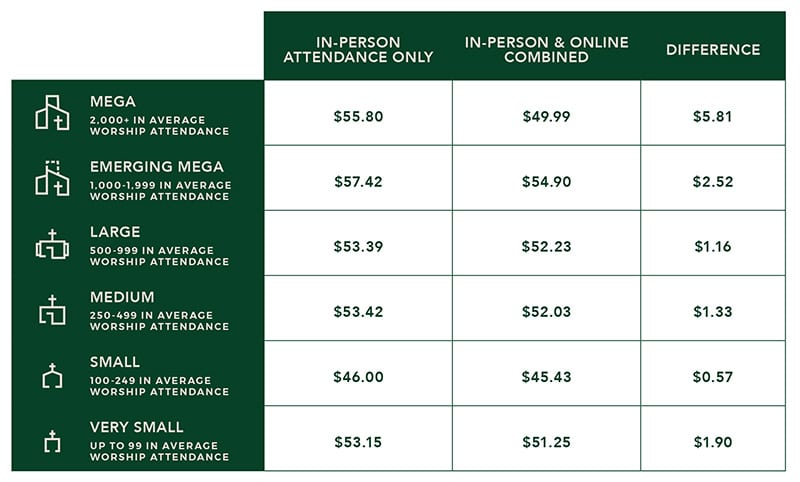By Kent E. Fillinger
Prior to the pandemic, most larger churches were already actively and sometimes aggressively using online church as an outreach strategy to connect with more people beyond their physical locations. For many smaller churches, the pandemic expedited their technological timeline and forced them into the realm of online church.
Every church I know is still trying to “crack the code” to determine how to shift people from “passive viewers” of online church to “engaged disciples.” Some churches have invested significant time, staffing, and financial resources to expand their online push and to upgrade their technology. Despite these investments, a proven process for moving people from consumers to contributors remains elusive.
My March/April 2022 Metrics article, “Authentic Online Church,” suggested a model for doing so, and it encouraged churches to see online church as a supplement to in-person worship and to be honest in how they count and report online attendance. It also suggested a simple method for how to count online church viewers.
Christian Standard focused solely on in-person worship attendance in our annual church report (May/June 2022 issue), but there’s still value in understanding how churches approach online church and to see what we can learn from the recent survey data.
Online Attendance Numbers
Of the 412 churches that participated in our survey, 322 (78 percent) reported online weekly attendance figures ranging from an average of 2 to 18,895 viewers. In 2021, the combined average weekly online attendance reported for these churches was 199,307—an average of 619 online viewers per church. If in-person average weekly worship attendance were added to online average weekly worship attendance as it had been in years past, the online attendance numbers would represent 45 percent of the total attendance of 442,617.
Overall, 14 percent of the churches that completed our survey reported an average online worship attendance for 2021 that was larger than their average in-person attendance. Two-thirds of the megachurches reported more online viewers than in-person attendees. Less than one-third (30 percent) of emerging megachurches reported more online viewers than in-person attendees. Small churches and very small churches were the least likely to report higher online than in-person attendance (5 percent and 7 percent, respectively).
Online Methods Used
The churches surveyed used a variety of online broadcast methods. Seven out of eight churches (87 percent) livestreamed their worship services in their entirety. Just under two-thirds (63 percent) of churches offered their full worship service on demand from their website. Less than one-third (32 percent) of churches provided only the message on demand on their website. And one-fourth of the churches rebroadcast their worship services after the fact.
Online Giving
Online giving was an option at 88 percent of the churches surveyed. That method of giving was a lifesaver for many churches during pandemic-related closures because it enabled a steadier flow of giving amid irregular attendance patterns.
Despite these two factors—large numbers of online attendees and the high use of online giving—our survey found that the bulk of a church’s giving came from in-person worshippers. Thus, online attendees are more likely to be consumers than contributors. The chart below, which shows average per-person giving based on general fund giving only, illustrates this point.
Anyone who has tracked our per-person giving over the years will note that these averages are much larger than they have been historically—up about $20 per person on average. This indicates that while churches may be averaging only about three-fourths of their pre-pandemic, in-person worship attendance, those people who left were contributing very little. Now it’s clearer that the core members and attendees who have remained have been and still are providing the lion’s share of a church’s weekly giving.
When Do Churches Count Online Viewers?
More than half of the churches surveyed (58 percent) said they “only count worship attendees after they [viewers] watch a specific amount of time.” The amount of viewing time required to be counted as an online worshipper decreased slightly from 2020 to 2021, from 13 minutes to 12 minutes, respectively. Emerging megachurches required the highest average amount of time watched—16 minutes—to be counted as an online worshipper. Medium churches had the shortest time requirement, 10 minutes. Only 2 percent of the churches used 60 minutes as their minimum time guideline to count a viewer as a worship participant. Conversely, 15 percent of the churches reported that someone needed watch only for one minute to be counted as an online attendee.
I hope someday soon churches will stop including these “scroll by” viewers to inflate their online worship attendance numbers. If someone walked into your worship center during a service and then left after a minute, would your church count that person as an in-person attendee?
How Many Pairs of Eyes Are Watching the Screen?
In my “Authentic Online Church” article, I advocated a simple, straightforward approach for counting online viewers: Churches should count one device as one online worshipper. (This method would avoid the use of “dishonest scales” that can baselessly inflate online numbers unnecessarily.)
Half of the churches that reported online attendance figures said they used a “multiplier” of from 1 to 3 per device to determine their online attendance numbers. (For example, Church A and Church B might both have exactly 100 devices tuning in to worship, but Church A uses a multiplier of 1 for 100 total viewers, while Church B uses a multiplier of 3 for 300 total viewers.) The overall average multiplier used last year was 1.8 attendees per device. Thus, the average church multiplies the number of devices watching by 1.8 to determine total online attendance. This is an improvement over 2020 when the overall average multiplier used was 2.03, so we’re trending in a better direction.
In 2021, megachurches and medium churches used the highest multiplier in our survey—an average of 1.9—followed closely by emerging megachurches and large and small churches, which used an average multiplier of 1.8. Very small churches used the lowest multiplier—1.5.
I segmented out the churches that reported using a multiplier to see what impact the multiplier had on their online attendance numbers. The combined average weekly online worship attendance for these churches was 156,860 when including the multiplier. If each of these churches had counted one device as one attendee—thus removing the multiplier—then the combined average weekly online worship attendance would have shrunk by 40 percent to 93,581.
Digital Attendance Tracking
As technology continues to improve, new options are available for churches to incorporate into their online church services. One helpful tool is a digital welcome or attendance card for online viewers to complete. The digital attendance card enables a church to know how many people are watching their online services, thus it takes the guesswork out of the attendance counting process. A little more than one-third (36 percent) of the churches said they use a digital welcome or attendance card for their online viewers.
Ironically, almost half (48 percent) of the churches that reported using a digital welcome or connection card to track online attendance still used a multiplier to report their online attendance.
Why would a church continue to use a multiplier when they also use a digital attendance card to track attendance? Truthfully, I’m unsure; I’ll try to provide an answer by next year’s report.



Why would a church continue to use a multiplier when they also use a digital attendance card?
I’m not sure they need to be mutually exclusive. A good online form (or digital attendance card) may likely ask how many are watching with you today. It’s highly unlikely that each person in a living room will take the effort to fill out the card. This information can actually provide a more substantive multiplier. I know of at least one church that bases its multiplier directly on the number of attendees per online card.
I am finding that though there our hundreds of views….theres not much time actually watching the livestream service. I am finding that the average time watching the actual livestream service is 2.5 minutes. Most are only viewers not watchers. There is a difference.